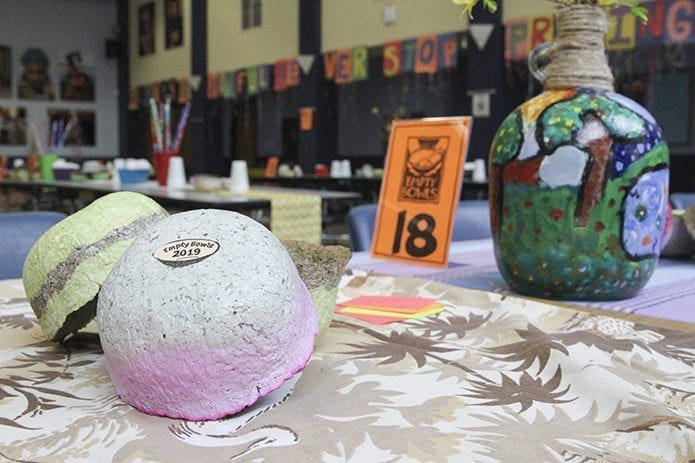 Photo By Michael Alexander
Photo By Michael AlexanderDecatur
‘Empty Bowls’ dinner fights hunger in Haiti
By ANDREW NELSON, Staff Writer | Published March 7, 2019
DECATUR—More than 500 people attended the Empty Bowls fundraising dinner of St. Thomas More School to support the people of Haiti.
The sixth annual dinner—a simple meal of soup—took over Mulhern Hall at St. Thomas More Church the evening of Feb. 21.

St. Thomas More School fourth-grader Evelyn Ballew pours some water for Gillian Beckford, third from right, as her daughter Abigail, far right, a kindergarten student, drinks from her cup. Students took turns serving in shifts throughout the Empty Bowls Dinner. Photo By Michael Alexander
Art teacher Cate Miller, who leads the effort, said the project reminds students, parents and the school community of the hunger in the world lived by many children and families.
For the past five years, two nonprofit community organizations in Haiti have benefited from the Decatur fundraiser. One is a ServeHaiti medical clinic in Grand Bois where the money buys a nutritional supplement to help children recover from malnutrition and the other is the Good Shepherd School, with its effort to provide education and health care.
Good Shepherd School, founded in 1982 in Port-au-Prince, educates about 1,000 students and employs more than 30 Haitians. The school’s aim is to educate the young people, while also providing basic healthcare and a hot meal daily.
Rev. Charlie Scott, who founded the school with his wife, Mary, said the school offers children living in a massive slum a chance for an education and a meal. The school was wrecked in the 2010 earthquake, but soon construction is to begin on the library, he said.
Half of the young people only get one meal a day, living in extreme poverty, he said. If people can experience the need, they would be surprised how $25 or $30 a day can change the trajectory of a youngster’s life, said Scott.
Miller said over the years each Empty Bowl event makes close to $3,000, which is shared between the Haitian projects. The dollars may not seem much for efforts here, but in Haiti the money is a windfall for improving nutrition and providing food, she said.

St. Thomas More Church parishioner Bill Grothaus holds his 10-month-old grandson Avan Gilmer while sitting next to Avan’s brother, five-year-old Olin. The Gilmer boys have a brother and sister at St. Thomas More School, who are in the second and sixth grade, respectively. Photo By Michael Alexander
At St. Thomas More, with its nearly 500 students, the Empty Bowls Dinner almost takes over the school’s focus for a few weeks leading up to the event. Haitian music is played in the lunchroom. Teachers include Haiti in their classroom prayers and young people are taught a few local phrases.
Miller said the school holds up the people of Haiti as models for a joyful spirit and for their hopefulness in the face of bad situations. The event also encourages young people to conserve and reduce waste, she noted.
“We do waste a lot. Haitians do not,” Miller said.
On the evening of the dinner, parents and families gathered in the parish hall to choose a soup of either a potato or tomato variety, along with a roll, a cookie, and water. Students also get the chance to serve as wait staff. The $6 price of adult admission allows families to take home colored paper pulp bowls made by students in art and colored with natural ingredients such as blueberries, coffee grounds or turmeric.
Miller said she hopes the bowls serve as artistic reminders about hunger issues in the world.
In addition to the dinner, there’s a marketplace set up in the dining area where crafts and jewelry made by hand in Haiti are sold.